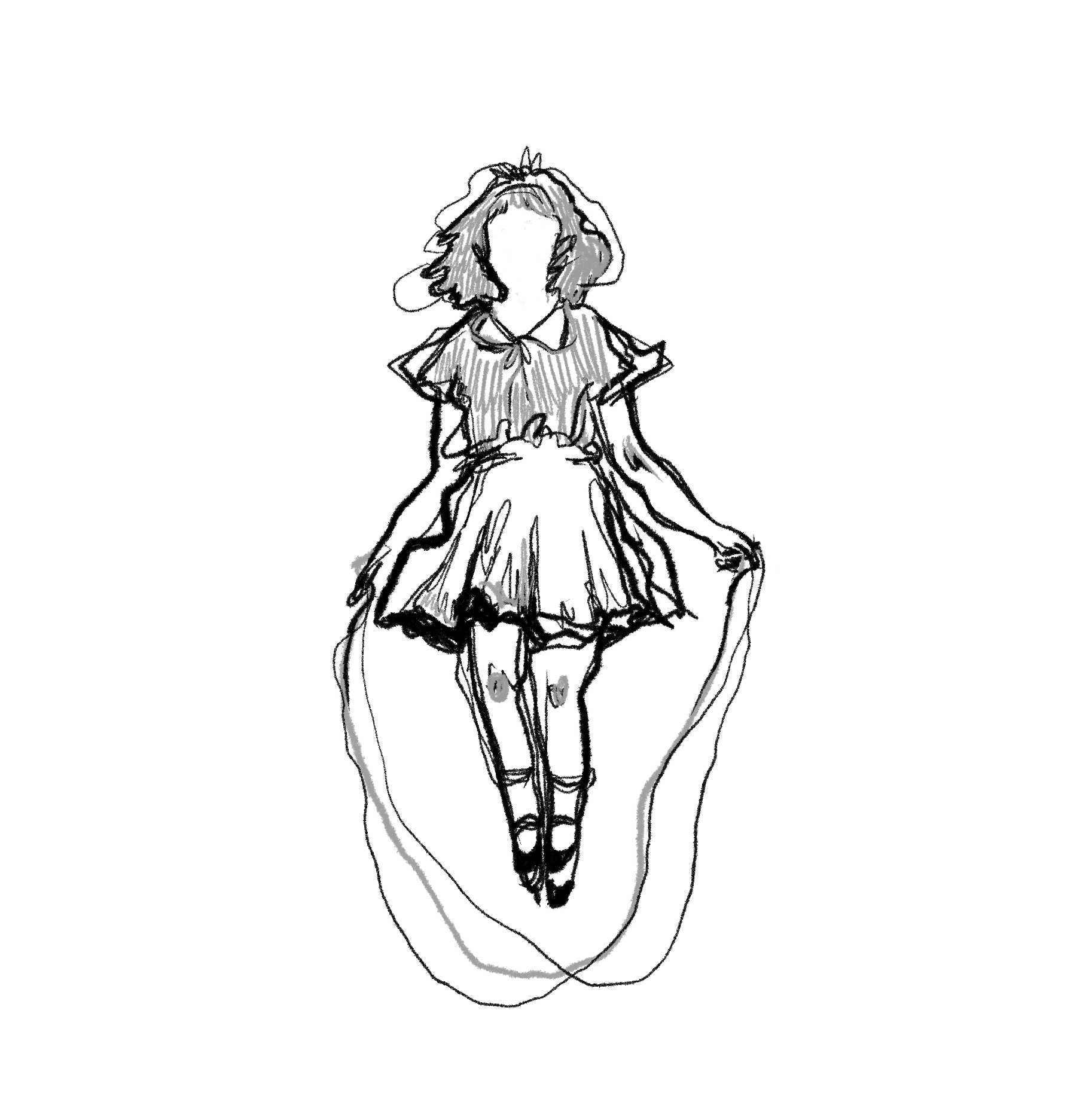Portrait of a girl at play
April 5, 2024
 Celeste Mercier
Celeste Mercier“(I realize that I am forever combing reality for signs of literature.)” – Annie Ernaux, “Exteriors.”
From 1985 to 1992, French writer Annie Ernaux kept a diary of a new town (more to the point: of the people—strangers—in it.) In “Exteriors,” she chronicled hands-held on the Métro, conversations overheard in markets and graffiti sprayed on sidewalks. Transitory but far from temporary, Ernaux’s momentary encounters in the town of Cergy-Pontoise shaped her conception of self and community.
This sentence is preceded by Ernaux’s retelling of a story overheard on the Cergy-Paris commuter line. Fellow passengers turn to listen as an unknown woman loudly recounts an incident in her mother’s apartment building. As the story reaches its climax—filled with “horror” and “enjoyment” and “postponement” and a neighbor discovered dead behind a heavy door—Ernaux reaches her grand yet parenthetical inclusion.
(Ernaux loves the grand yet parenthetical inclusion.)
“Exteriors” holds in its diaristic depictions of reality many of the telltale signs of great literature: characters are sympathetic and admirable and morally shaky, the setting envelops the reader, plotlines stand as allegories relating fundamental truths. That this sentence is parenthetical suggests that it marks a break from an ongoing narrative, lending further to the melding of truth and storytelling. This rule-phrased-as-realization summarizes both Ernaux’s writerly doctrine and the cause of this column.
Annie Ernaux’s skilled weaving of the literary and the real won her the 2022 Nobel Prize in Literature, “for the courage and clinical acuity with which she uncovers the roots, estrangements and collective restraints of personal memory.” In “Exteriors,” the personal meets the collective in epiphanies such as this sentence, or when Ernaux imagines the interior lives of unknown couples, or reprints (spelling errors and artistic embellishments included) lines of graffiti that strike her:
“ALGERIA I LOVE YOU,” Ernaux reads in the paint. And “IF YOUR CHILDREN ARE HAPPY THEY ARE COMUNISTS.” And “THERE ARE NO INFERIOR MEN.”
These lines illustrate that Ernaux’s parenthetical rule operates also in reverse. Just as reality is enhanced by the search for literature, the best literature seeks to reflect upon the real, offering some essential truth.
As Ernaux noted in her Nobel acceptance speech: “Finding the words that contain both reality and the sensation provided by reality would become, and remain to this day, my ongoing concern in writing, no matter what the subject.”
Ernaux writes on such themes as gender and labor through the lens of her femininity and working-class family (and the dual violence and assurance involved for her in both identities). The beauty of her words is enhanced, continually, by her search for “political and intimate emancipation.”
(I realize that I am forever combing literature for signs of reality.)
I first read “Exteriors” (though I already revered Ernaux) after visiting the Maison Européenne de la Photographie (MEP) in Paris, where the book is put on visual display. Lines from the text are printed alongside photographs taken from 1940 to 2021 which emphasize, as Ernaux’s written encounters do, the persistence of the momentary.
Included in the exhibit are works by French photographer Claude Dityvon (1937-2008). In one image, a young girl is framed mid-air as she jumps rope. This photograph captures an instance that cannot last: The girl must come down, lay down her rope and grow up. She is now far older than I. Dityvon’s image is thus necessarily both fictional and documentary. It is a photographic combing of reality for literature.
Dityvon is known largely for his photographs of Paris’s student protests of May 1968. Though the students were young and their immediate protest mere weeks long, their revolutionary aims shifted France’s political world for decades. The students set off a social revolution, changing conceptions of liberation and altering permanently the bounds of French left political parties. Dityvon’s images serve as a permanent artifact of scenes of commotion, passion and pushback, confined to the past and yet lasting in their impact. “In Claude Dityvon’s photographs,” a caption at the MEP reads, “figures are both alone and together, briefly sharing space, before moving on—perhaps unchanged, perhaps profoundly affected.”
My friend and I left the house in which the MEP resides and walked through Le Marais attuned to exteriors—to brief encounters and the stories they may contain. As Ernaux and Dityvon dually convey, the literary value of reality consists of finding profundity within brevity.
Dityvon’s photograph of the young girl jumping rope was taken in but a fraction of a second. But to viewers, strangers upon an intimate scene, she is frozen in her youth. The photograph is a story of play tinged with the inherently political confession that play must always come to an end. May her reality be imbued with signs of literature: May she never come down.

Comments
Before submitting a comment, please review our comment policy. Some key points from the policy: